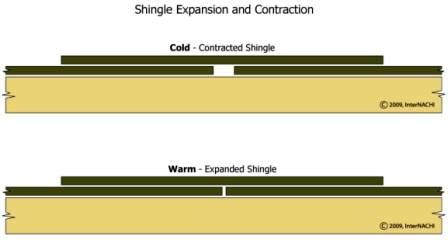Splitting Over Shingle Joints
Shingle splitting due to temperature-related expansion and contraction is called thermal splitting. Thermal splitting typically happens where shingles bridge the joints in the underlying layer of shingles.
There are no industry standards that specify the minimum bond strength of shingle adhesive strips. If the adhesive strips bond shingles together strongly enough, the shingles on a roof slope can act almost as a single membrane.

As shingles warm and expand, the joints between them become smaller. As shingles cool and shrink, the joints between them grow wider.
The shingles that bridge those underlying joints are shrinking, too, and these bridging shingles becoming increasingly stressed as the entire bonded-shingle assembly continues to shrink.
If this stress exceeds a critical point, one of two things will happen:
1. If the strength of the bond of the adhesive strips exceeds the tensile strength of the shingles, the shingles bridging the joints will split, creating an opportunity for leakage to develop.
2. If the tensile strength of the shingles surpasses the strength of the adhesive bonds, the bonds will fail, drastically lowering the wind resistance of the shingles.
Thermal splitting over joints between shingles may form a diagonal pattern up the roof following the stair-step pattern of the offset joints created during installation, or it may appear randomly above joints in different parts of the roof.

